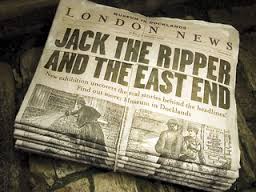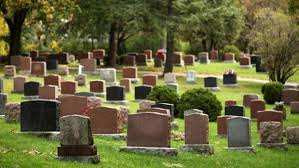 Thirty-three years ago this week, six members of the Johnson and Bentley families – three generations – were savagely slaughtered by a sick bastard who’d stalked them for days while they camped at Wells Gray Park in central British Columbia, Canada. The motive for the murders and what actually happened is beyond disgusting. It’s truly unspeakable.
Thirty-three years ago this week, six members of the Johnson and Bentley families – three generations – were savagely slaughtered by a sick bastard who’d stalked them for days while they camped at Wells Gray Park in central British Columbia, Canada. The motive for the murders and what actually happened is beyond disgusting. It’s truly unspeakable.
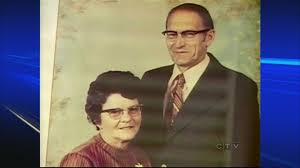 The victims were grandparents George Bentley, 66, and Edith Bentley, 59; parents Bob Johnson, 44, and Jackie Johnson, 41; and daughters Janet Johnson, 13, and Karen Johnson, 11. They rendezvoused for a summer vacation at the remote wilderness recreational area (300 miles northeast of Vancouver and 465 miles northwest of Calgary) and picked a secluded camp spot at the old Bear Creek prison site. The Johnsons drove up by car and pitched a tent for the girls. The Bentleys arrived with a truck and camper to house the adults.
The victims were grandparents George Bentley, 66, and Edith Bentley, 59; parents Bob Johnson, 44, and Jackie Johnson, 41; and daughters Janet Johnson, 13, and Karen Johnson, 11. They rendezvoused for a summer vacation at the remote wilderness recreational area (300 miles northeast of Vancouver and 465 miles northwest of Calgary) and picked a secluded camp spot at the old Bear Creek prison site. The Johnsons drove up by car and pitched a tent for the girls. The Bentleys arrived with a truck and camper to house the adults.
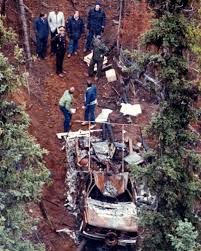 The families were reported missing on August 23, 1982, when Bob Johnson failed to show up for work. An extensive search was launched. It spread across central British Columbia as their known destination was only somewhere in the Wells Gray area, which is huge. This was long before the day of cell phones and email.
The families were reported missing on August 23, 1982, when Bob Johnson failed to show up for work. An extensive search was launched. It spread across central British Columbia as their known destination was only somewhere in the Wells Gray area, which is huge. This was long before the day of cell phones and email.
On September 13, the Johnson family car was found burned in a clearing off a mountainside logging road, thirteen aerial miles from Bear Creek. In the back seat were the incinerated remains of the four adults and, in the trunk, were the two girls. The bodies were so consumed that they were eventually interred together in one child-sized casket.
Forensic analysis determined they’d been shot in the head with a .22 caliber firearm.
The murder scene was located through information from locals who’d seen the family camped at Bear Creek. Spent .22 casings were recovered which allowed a ballistic match to the weapon, just as .22 bullet leads were extracted from what was left of the skulls.
 The Bentley’s 1981 Ford truck with its camper was missing, as well as other possessions such as their boat and motor, camping gear, and all the things families on holidays would have.
The Bentley’s 1981 Ford truck with its camper was missing, as well as other possessions such as their boat and motor, camping gear, and all the things families on holidays would have.
The case gained huge media attention and prompted tips from across North America. A promising lead was the truck and camper reportedly being seen in central Canada, driven eastbound by two scruffy French-Canadian men. This prompted a wild goose chase where the police drove a replica vehicle across the nation to solicit more sighting information.
Over 13,000 tip files were investigated by many police agencies, all reaching a dead end. On October 18, 1983 – fourteen months after the murders – the Bentley truck and camper was found near the crime scene. It, too, had been burned and was in a nearly impossible-to-see place on the side of different mountain from where the car and bodies were found.
The investigation team focused back on the local area. They honed-in on 24 year old David William Shearing who lived at the nearest property to the murder scene. Like so many crimes – especially the truly bizarre ones – the answer is usually close to home.
 Skillful interrogation by two Royal Canadian Mounted Police detectives, Sergeant Mike Eastham and Constable Ken Liebel, got David Shearing to confess, re-enact the murders, and turn over the family’s possessions. He also handed the police a .22 caliber Remington pump-action rifle, which was forensically matched as the murder weapon.
Skillful interrogation by two Royal Canadian Mounted Police detectives, Sergeant Mike Eastham and Constable Ken Liebel, got David Shearing to confess, re-enact the murders, and turn over the family’s possessions. He also handed the police a .22 caliber Remington pump-action rifle, which was forensically matched as the murder weapon.
Shearing stated in his initial confession that he shot the four adults as they sat around their campfire, then shot the girls as they slept in the tent. He claimed his motive was robbery; he wanted their money and possessions. He told the investigators he loaded the bodies into the car, drove it by night to the mountainside, and set it on fire using five gallons of gasoline as an accelerant. He said he cleaned the campsite, then took the truck/camper back to his nearby property, only to burn it later when he discovered how difficult it was to re-register.
David Shearing pleaded guilty to six counts of murder and was given a life sentence with no possibility of parole for twenty-five years. Following Shearing’s conviction, Mike Eastham re-interviewed him and got the truth behind the murders.
 Shearing was a pedophile and fixated on the little girls. He’d spotted the family the moment they set up camp and spent several days spying on them from a hillside, fantasizing about having sex with the kids. At dusk on (or about) August 10, 1982, Shearing crept through the shadows into the campsite with his rifle and opened fire, ambushing the adults who surrounded the fire. He captured the girls and took them to his property where he kept them alive for a week, repeatedly raping the children. On August 16, Shearing shot Karen in the back of the head. The next day he killed Janet the same way.
Shearing was a pedophile and fixated on the little girls. He’d spotted the family the moment they set up camp and spent several days spying on them from a hillside, fantasizing about having sex with the kids. At dusk on (or about) August 10, 1982, Shearing crept through the shadows into the campsite with his rifle and opened fire, ambushing the adults who surrounded the fire. He captured the girls and took them to his property where he kept them alive for a week, repeatedly raping the children. On August 16, Shearing shot Karen in the back of the head. The next day he killed Janet the same way.
Shearing took the girl’s bodies back to the Johnson family car, which he’d hidden in the bush, and stuffed them in the trunk. Then he drove the car – containing six lifeless human beings, four of who’d been decomposing for a week in the summer heat – on a ride up the mountain where he burned them.
The Johnson – Bentley case has a personal side with me.
Mike Eastham and Ken Liebel were colleagues of mine. I was with the RCMP’s northwestern BC criminal investigation section at the time of the ‘J-B’ murders and I helped follow-up tips in the file – just like many other police officers across the nation did.
 I’ve handled the J-B murder weapon at the forensic laboratory in Vancouver and I’ve worked the action and I’ve looked down the sights. I’ve contemplated how such a small, mechanical device did such incomprehensible damage in the hands of a monster. I’ve envisioned that ride – Shearing chauffeuring a car-load of rotting bodies up to their funeral pyre – but where I can’t go is the unspeakable… unimaginable… terror… horror… that Janet and Karen Johnson endured. I know some of the details and they’re truly unprintable.
I’ve handled the J-B murder weapon at the forensic laboratory in Vancouver and I’ve worked the action and I’ve looked down the sights. I’ve contemplated how such a small, mechanical device did such incomprehensible damage in the hands of a monster. I’ve envisioned that ride – Shearing chauffeuring a car-load of rotting bodies up to their funeral pyre – but where I can’t go is the unspeakable… unimaginable… terror… horror… that Janet and Karen Johnson endured. I know some of the details and they’re truly unprintable.
 David Shearing (now David Ennis because the coward changed to his mother’s maiden surname) was denied parole in 2012 and withdrew his application in 2014 when a petition with 13,258 signatures was presented to the National Parole Board, mine being one of them. He’s now eligible to apply every two years and, if this breathing piece of shit tries it again in 2016, you’re going to hear me ask for your signature on another petition.
David Shearing (now David Ennis because the coward changed to his mother’s maiden surname) was denied parole in 2012 and withdrew his application in 2014 when a petition with 13,258 signatures was presented to the National Parole Board, mine being one of them. He’s now eligible to apply every two years and, if this breathing piece of shit tries it again in 2016, you’re going to hear me ask for your signature on another petition.
David William Shearing, aka Ennis, is a monster from the shadows of Wells Gray Park.
He must die behind bars.
* * *
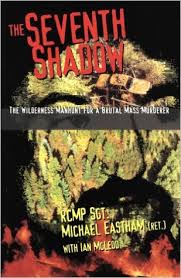 Retired RCMP Sergeant Mike Eastham co-authored a book with Ian McLeod on the Johnson–Bentley investigation. Outside of telling the truth of what Shearing did, and must pay for with the rest of his life, it’s a fascinating look at a major murder investigation and how personalities work for – and against – it.
Retired RCMP Sergeant Mike Eastham co-authored a book with Ian McLeod on the Johnson–Bentley investigation. Outside of telling the truth of what Shearing did, and must pay for with the rest of his life, it’s a fascinating look at a major murder investigation and how personalities work for – and against – it.
My opinion – Mike Eastham (and a hell of a lot of others) did a great job in bringing Shearing to justice and Mike told a great story. I highly recommend The Seventh Shadow – The Wilderness Hunt for a Brutal Mass Murderer.
Here’s the link: http://www.amazon.com/Seventh-Shadow-Wilderness-Manhunt-Brutal/dp/1894020472/ref=sr_1_1?s=books&ie=UTF8&qid=1439589512&sr=1-1&keywords=the+seventh+shadow
Here’s the new 2018 CBC hour-long The Detectives story on the J-B murders narrated by Mike Eastham – https://watch.cbc.ca/share/episode/2e8c34bb-f55c-4017-8630-02d3ae3cb2bb Mike does an excellent narration supported by professional actors.
There is an excellent documentary called “The Wells Grey Gunman David Shearing“. It’s produced by “True Crime Stories” that tells the story of the investigation, Shearing’s arrest/confession, and what his motivation was for the Johnson-Bentley murders. I personally know a number of the actual investigators who are interviewed in the show and I can say that this documentary is presented accurately and fairly. It’s well worth the 45-minute watch.
Here’s the link: http://www.lectoro.com/index.php?action=search&ytq=Crime%20Stories%20%20%20The%20Wells%20Grey%20Gunman%20David%20Shearing


